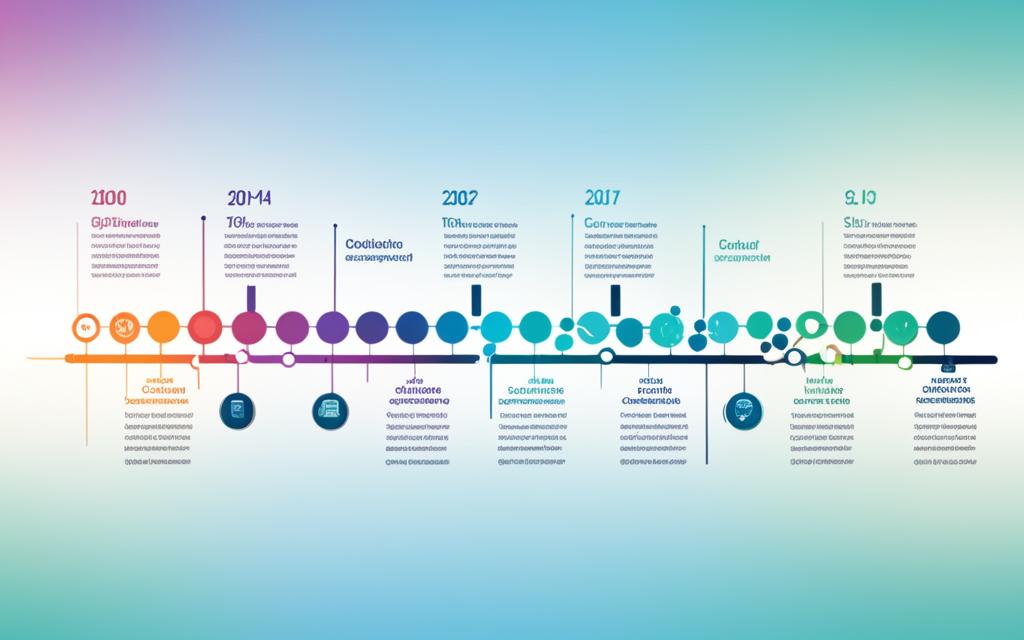The evolution of cellular networks has been a driving force behind the advancement of modern telecommunications. From the introduction of Japan’s first commercial 1G network in 1979, to the groundbreaking capabilities of 5G and beyond, the cellular network industry has witnessed remarkable transformations.
In this article, we will explore the evolution of cellular networks through each generation, discussing the technological advancements that have shaped the landscape of mobile communication. From the analog beginnings of 1G to the digital revolution of 2G, the rapid expansion of 3G, and the data-intensive capabilities of 4G, cellular networks have continually evolved to meet the increasing demands of users.
By understanding the progression of cellular networks, we can appreciate how each generation has expanded the possibilities of communication and connectivity. From the limitations of early networks to the fast-paced world of mobile applications and internet of things (IoT), cellular networks have played a vital role in shaping the way we live and work.
Join us on this journey as we delve into the fascinating evolution of cellular networks, exploring their impact on our lives and the promising future that lies ahead.
Introduction to Cellular Networks
Cellular technology serves as the backbone of modern mobile phone networks, enabling seamless communication and high-speed data transmission. In this section, we will delve into the fundamental components of a cellular network, illustrating how this intricate infrastructure facilitates reliable voice and data connectivity.
Components of a Cellular Network
Cellular networks consist of several essential components that work together to ensure efficient and wide-ranging connectivity. These components include:
- Cell Sites: Cells, or cell sites, are strategically positioned throughout a geographic area to provide coverage. Each cell site comprises a base station equipped with antennas and transceivers that transmit and receive signals from mobile devices.
- Radio Access Networks (RAN): The Radio Access Network functions as the intermediary between cell sites and mobile devices. It handles the wireless communication between devices and the core network, facilitating seamless connectivity and data transmission.
- Core Network: The Core Network serves as the central hub of a cellular network. It is responsible for managing and routing voice and data traffic, connecting the cellular network with other networks such as the Public Switched Telephone Network (PSTN) and the Internet.
Advancements in Cellular Technology
Over the years, cellular technology has undergone significant advancements, resulting in improved network performance and enhanced user experiences. These advancements include:
“Cellular technology has paved the way for transformative changes, revolutionizing the way we communicate and access information.”
- Introduction of digital networks: The transition from analog to digital networks, such as the Global System for Mobile Communications (GSM), enabled more efficient use of available frequencies and increased capacity, leading to improved call quality and reduced interference.
- Emergence of mobile internet: With the evolution of cellular networks, the seamless integration of mobile devices with the internet became a reality. This opened up opportunities for accessing email, browsing the web, and utilizing various internet-based services on the go.
- Expansion of data capabilities: Cellular networks have evolved to support faster and more reliable data transmission, facilitating multimedia capabilities like video streaming, online gaming, and real-time collaboration.
As we delve deeper into the subsequent sections of this article, we will explore the distinctive features and evolution of each generation of cellular networks, from the analog 1G networks to the cutting-edge capabilities of 5G.
First Generation (1G) Technology
The advent of analog telecommunications standards marked the era of 1G, which primarily focused on delivering foundational voice services. Analog wireless networks formed the backbone of 1G technology, enabling voice calls over cellular networks for the first time.
Despite its groundbreaking capabilities, 1G technology had several limitations that hindered its widespread adoption and effectiveness. One of the major drawbacks was its limited capacity, which meant that only a limited number of users could be served by the network at any given time.
Furthermore, the call quality in 1G networks was often subpar, as the analog signal was susceptible to interference and transmission errors. This resulted in poor voice clarity and dropped calls, making communication less reliable.
Security was another major concern in 1G networks. Analog signals were not encrypted, making it easier for unauthorized individuals to intercept and eavesdrop on conversations. This lack of security compromised the privacy of voice calls and posed a significant risk to users.
Despite these challenges, 1G networks laid the foundation for subsequent generations of cellular technology. The advancements made in voice services and wireless communication paved the way for improvements in subsequent generations, including better voice quality, increased data capacity, enhanced security features, and faster transmission speeds.
As technology continued to evolve, analog networks were gradually replaced by digital networks, leading to the introduction of 2G technology.

Image: Analog Wireless Network
Second Generation (2G) Technology
2G technology marked a significant leap forward compared to the previous 1G networks. It introduced digital transmission methods that allowed for more efficient use of the network, increased capacity, and the introduction of text messaging or Short Message Service (SMS).
One of the key advancements in 2G was the adoption of digital radio signals, known as Global System for Mobile Communications (GSM). This shift from analog to digital enabled clearer voice and data communication, paving the way for the development of various mobile services.
With the introduction of SMS, users could now send and receive text messages, revolutionizing the way people communicated. This breakthrough feature, which quickly became immensely popular, opened up new avenues for personal and professional interactions.
Moreover, 2G technology laid the foundation for the development of mobile internet and mobile commerce. As digital signals allowed for more efficient data transfer, users gained access to basic internet services on their mobile devices. This breakthrough set the stage for the subsequent growth of mobile internet usage and the myriad of benefits it offers in terms of communication, information access, and entertainment.
Third Generation (3G) Technology
With the emergence of 3G technology, a new era of mobile communication unfolded, bringing significant advancements in data speed and network capabilities. The International Telecommunication Union (ITU) standard for 3G systems revolutionized the way we connect and access information, enabling a wide range of multimedia capabilities.
3G networks paved the way for services like video calling, video streaming, gaming, and fast internet browsing, transforming the mobile experience for users worldwide. The introduction of 3G technology, also known as Universal Mobile Telecommunications System (UMTS), marked a turning point in mobile communication, enabling users to access a wealth of multimedia content on their devices.
High-Speed Data Networks
3G systems are classified as high-speed data networks, offering faster data transfer speeds compared to their predecessors. These networks operate on various radio technologies like Time Division Multiple Access (TDMA), Code Division Multiple Access (CDMA), and Frequency Division Multiple Access (FDMA), ensuring efficient utilization of the available spectrum.
Coexistence with 2G Technologies
3G systems coexist with 2G technologies, providing enhanced coverage and network capabilities. This coexistence allowed for a seamless transition between the generations, ensuring wider accessibility to mobile services. With 3G, users experienced improved data transfer speeds, enabling them to download files, stream videos, and browse the internet at a much faster rate.
Energy Efficiency
Efficiency was a key aspect of 3G technology, as it aimed to optimize performance while maximizing battery life. By efficiently managing power consumption, 3G systems offered a balance between network capabilities and energy efficiency, ensuring that users could enjoy their multimedia-rich experiences without compromising device performance or battery life.

| Advantages of 3G Technology | Disadvantages of 3G Technology |
|---|---|
|
|
Fourth Generation (4G) Technology
As the next step in the evolution of cellular networks, 4G technology revolutionized the mobile landscape by addressing the challenges of higher data rates and network capacity. It brought about a significant improvement in signal strength, data transfer speeds, and voice call quality, providing users with a seamless and efficient communication experience.
One of the key advantages of 4G technology is its ability to deliver faster data rates, allowing for quicker downloads, seamless streaming of high-definition videos, and smooth online gaming experiences. With 4G, users can access mobile applications and services with enhanced speed and efficiency, enabling them to stay connected and productive on the go.
Improved Network Capacity
4G networks have a much higher capacity compared to their predecessors, enabling them to handle a larger number of simultaneous connections and data-intensive activities. This increased capacity is crucial in today’s digital era, where the demand for bandwidth-intensive applications such as streaming, video conferencing, and cloud-based services continues to grow.
In addition, 4G networks offer improved network efficiency, allowing more users to connect to the network at the same time without compromising on data speeds or quality. This improved network capacity opens up new opportunities for businesses and individuals alike, facilitating seamless collaboration, productivity, and communication.
Unleashing the Power of Mobile Applications
4G technology played a pivotal role in the rapid development and adoption of mobile applications. With faster data rates and increased bandwidth, 4G networks enabled the seamless use of a wide range of mobile applications, from social media platforms and entertainment apps to productivity tools and e-commerce applications.
Mobile applications have become an integral part of our lives, providing convenience, entertainment, and information at our fingertips. The high-speed connectivity offered by 4G networks unlocked the full potential of these applications, allowing users to access real-time data, stream videos, play online games, and perform complex tasks with ease.
Furthermore, 4G networks paved the way for the growth of IoT (Internet of Things) devices and applications. By supporting real-time data exchange between connected devices, 4G enabled the development of smart homes, connected cars, and various other IoT applications, bringing us closer to the vision of a fully interconnected world.
Conclusion
The evolution of mobile communication has had a profound impact on our society, transforming the way we connect and access information. From the analog 1G networks of the past to the advanced capabilities of 5G networks, each generation has brought remarkable advancements in voice quality, data capacity, speed, and the emergence of new applications and services.
As we continue to pave the way towards the future of cellular networks, 5G technology stands at the forefront, promising a more connected, immersive, and efficient world. With its lightning-fast speeds, ultra-low latency, and massive network capacity, 5G has the potential to unlock tremendous possibilities in various industries.
Imagine a world where autonomous vehicles communicate seamlessly with each other, where remote surgeries and virtual reality experiences are within reach, and where smart cities optimize resources and enhance urban living. These are just a few examples of the transformative power that 5G networks bring, and the impact they can have on our daily lives.
As we look ahead, we can expect to see the continued evolution of mobile communication, with advancements in network infrastructure, the proliferation of connected devices, and the rise of innovative technologies. The future of cellular networks holds promise for a more interconnected world, where mobile technology continues to shape and enhance our lives in ways we can only imagine.
FAQ
What is the evolution of cellular networks?
The evolution of cellular networks traces the development and advancements in mobile communication technology from 1G to 5G and beyond. Each generation of cellular networks has brought improvements in voice quality, data capacity, speed, and the emergence of new applications and services.
How does cellular technology work?
Cellular technology forms the foundation of mobile phone networks, enabling high-speed voice and data communication. It involves components such as cells or cell sites strategically dispersed across a wide geographic area, radio access networks, and the Core Network that handles essential operations and connects the cellular network to other networks like the PSTN and the Internet.
What is 1G technology?
1G technology refers to the first generation of cellular networks, which primarily focused on delivering foundational voice services. Despite its limitations in capacity, call quality, and security, 1G networks laid the foundation for subsequent generations, setting the stage for improvements in voice quality, data capacity, security features, and transmission speeds.
What are the key features of 2G technology?
2G technology brought about a revolutionary leap forward compared to 1G. It introduced digital transmission methods, enabling more efficient use of the network, increased capacity, and the introduction of text messaging (SMS). The adoption of digital radio signals allowed for voice and data communication, leading to the development of mobile internet and mobile commerce.
What advancements were brought by 3G networks?
3G networks brought significant advancements in data speed and network capabilities. They enabled services like video calling, video streaming, gaming, and fast internet browsing. 3G systems coexist with 2G technologies, offering improved coverage, higher data transfer speeds, and energy efficiency.
What are the benefits of 4G networks?
4G networks provided higher data rates and increased bandwidth, addressing the challenges of higher data rates and capacity. They improved signal strength, data transfer speeds, voice call quality, and supported data-intensive activities like gaming, streaming videos, and sending large documents. 4G networks also paved the way for the development of IoT devices and applications, supporting real-time data exchange between connected devices.



















